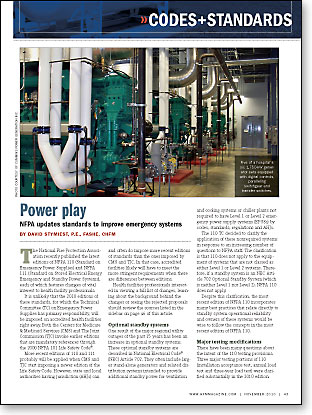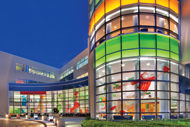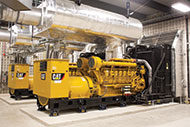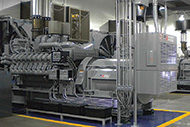 The National Fire Protection Association recently published the latest editions of NFPA 110 (Standard on Emergency Power Supplies) and NFPA 111 (Standard on Stored Electrical Energy Emergency and Standby Power Systems), each of which features changes of vital interest to health facility professionals.
The National Fire Protection Association recently published the latest editions of NFPA 110 (Standard on Emergency Power Supplies) and NFPA 111 (Standard on Stored Electrical Energy Emergency and Standby Power Systems), each of which features changes of vital interest to health facility professionals.
It is unlikely that the 2010 editions of these standards, for which the Technical Committee (TC) on Emergency Power Supplies has primary responsibility, will be imposed on accredited health facilities right away. Both the Centers for Medicare & Medicaid Services (CMS) and The Joint Commission (TJC) invoke earlier editions that are mandatory references through the 2000 NFPA 101 Life Safety Code®.
More recent editions of 110 and 111 probably will be applied when CMS and TJC start imposing a newer edition of the Life Safety Code. However, state and local authorities having jurisdiction (AHJs) can and often do impose more recent editions of standards than the ones imposed by CMS and TJC. In that case, accredited facilities likely will have to meet the more stringent requirements when there are differences between editions.
Health facilities professionals interested in viewing a full list of changes, learning about the background behind the changes or seeing the rejected proposals should review the sources listed in the sidebar below.
Optional standby systems
One result of the major regional utility outages of the past 15 years has been an increase in optional standby systems. These optional standby systems are described in National Electrical Code® (NEC) Article 702. They often include larger stand-alone generators and related distribution systems intended to provide additional standby power for ventilation and cooling systems or chiller plants not required to have Level 1 or Level 2 emergency power supply systems (EPSSs) by codes, standards, regulations and AHJs.
The 110 TC decided to clarify the application of these nonrequired systems in response to an increasing number of questions to NFPA staff. The clarification is that 110 does not apply to the equipment of systems that are not classed as either Level 1 or Level 2 systems. Therefore, if a standby system is an NEC Article 702 Optional Standby System (which is neither Level 1 nor Level 2), NFPA 110 does not apply.
Despite this clarification, the most recent edition of NFPA 110 incorporates many best practices that relate directly to standby system operational reliability and owners of these systems would be wise to follow the concepts in the most recent edition of NFPA 110.
Major testing modifications
There have been many questions about the intent of the 110 testing provisions. Three major testing portions of 110 (installation acceptance test, annual load test and three-year load test) were clarified substantially in the 2010 edition.
The TC reworded and reorganized the entire Installation Acceptance Testing section to clarify the TC's intent. There was some toughening of requirements, such as the new requirement to field-verify the engine start function throughout the entire EPSS. The 110 TC also added explanatory Annex language regarding this new requirement: "A.7.13.4.1.3(f) Verification of the engine start function can be accomplished through actual engine starting or by testing of the automatic transfer switch start circuit."
There also were some relaxations of installation acceptance testing requirements. For example, an automatic transfer switch (ATS) test switch is now permitted to start the installation acceptance test in existing occupied buildings and facilities rather than requiring a complete normal power outage for the first (previously 2-hour) portion of the installation acceptance test, as required in the 2005 edition. The 2010 edition incorporates a reduction from 2 hours to 1.5 hours for the first portion of the installation acceptance test in order to reduce engine exhaust emissions.
The TC alleviated the previous problem of how to switch from the first portion (with actual loads) of the initial acceptance test to the second portion (adding a load bank) in just 5 minutes by modifying the requirement from "5 minutes" to "not less than 5 minutes."
The TC also added in the Annex information about permanently installed equipment or connection points, such as spare circuit breakers or switches, for load banks and portable generators.
The second portion of the installation acceptance test remains at 2 hours, but the previous requirement for 100 percent block-load application was relaxed to a step-load application: "7.13.4.3.1 This full-load test shall be initiated after the test specified in 7.13.4.1.3 by any method that starts the prime mover and, upon reaching rated rpm, picks up not less than 30 percent of the nameplate kilowatt (kW) rating for the first 30 minutes, not less than 50 percent of the nameplate kW rating for the next 30 minutes and 100 percent of the nameplate kW rating for the next 60 minutes, less applicable derating factors for site conditions."
The annual load bank test was shortened from 2 hours to 1.5 hours, also to reduce engine emissions. The previous loading requirement for 25 percent, then 50 percent and, finally, 75 percent loading was modified to not less than 50 percent for 30 minutes, then not less than 75 percent for 60 minutes.
This annual load bank test is required only if the monthly testing does not comply with the minimum 30 percent loading criteria or meet the engine manufacturer's minimum recommended exhaust gas temperature. It is important that accredited health care facilities be careful not to take this change out of context and start doing 90-minute annual load tests. Health facilities professionals should remember that both TJC and CMS still state that annual load tests, when required, must be 120 minutes, a duration found in previous 110 editions.
The 3-year, 4-hour load test also was rewritten and reorganized to clarify the TC's intent. This modification relaxes several requirements, such as permitting the use of ATS test switches rather than requiring that the normal power to the ATSs be dropped. This change was in response to concerns that a generator
failure during the 4-hour test would result in a dead ATS unless the normal power source to the ATS stayed alive throughout the test, allowing the ATS to transfer back to normal power automatically.
The 110 TC also responded to the joint American Society for Healthcare Engineering/TJC request for a formal interpretation by allowing the 3-year test, one annual load test and one monthly load test to be a combined test. This change also reduces engine emissions. The author recommends that owners intending to take advantage of the combined test be sure to meet the most stringent criteria of the tests being combined to avoid issues with AHJs that might review the test reports.
Another testing clarification in several places was that durations and loading percentages were clarified to be minimums rather than absolutes. For example, such durations as "1.5 hours" were revised to be "not less than 1.5 hours." Similarly, such test loading percentages as "50 percent" also were revised to be "not less than 50 percent." These changes were made to clarify the TC's intent so that facilities would not be penalized by AHJs for conducting tests that were exceeding the minimum requirements.
Finally, the Annex clarifies that the 110 requirement for weekly EPSS inspections does not require running the generator set weekly. Many facilities run their generator sets unloaded weekly between monthly load tests because they mistakenly believe that 110 requires it. Of course, if the engine manufacturer recommends weekly running — or if a local code, standard or AHJ requires it — those recommendations or requirements might supersede the clarification.
Other changes
The 2010 edition clarifies that Chapter 8 (Routine Maintenance and Operational Testing) applies to both new and existing systems. The TC noted in its substantiation that Chapter 8 is written for existing systems and should be so noted or Chapter 8 could not be applied legally.
The previous Annex language that gave examples of Level 1 systems was removed and replaced with references to NFPA 20, NFPA 99 and NFPA 101 as examples of standards that require Level 1 systems. This change was made to eliminate confusion from AHJs and others who thought the previously listed examples were the only situations requiring Level 1 systems. In summary, 110 does not inform facility professionals what EPSSs are Level 1 or Level 2; it simply states what is required if they have these EPSSs in their facility.
The 2010 Annex also provides EPSS diesel fuel recommendations (not requirements). The submitter's substantiation in the Report on Proposals (ROP) gave detailed reasons for the proposal. It also stated, "Diesel fuels sold by reputable marketers meet or exceed this requirement" and specified that "Diesel fuel should be either 1D, 2D, or a blend and have a minimum cetane rating of 40."
In response to a public proposal and several questions directed to NFPA staff, the TC added a description of the term "cold start" to the Annex: "Cold start is typical standby condition under normal ambient conditions with coolant heaters functioning normally."
The monthly test requirement for spark-ignited engines also was modified to reflect that wet stacking is not an issue with that type of engine: "Spark-ignited generator sets shall be exercised at least once a month with the available EPSS load for 30 minutes or until the water temperature and the oil pressure have stabilized."
Lightning protection of emergency power supplies no longer is mandated by 110, but clarifying language now requires adherence to NFPA 780 where such lightning protection systems are required: "Where outdoor and/or rooftop Level 1 emergency power system (EPS) installations are required to be protected from lightning, the lightning protection system(s) shall be installed in accordance with NFPA 780."
The requirement for a low lube oil pressure pre-alarm was deleted because the TC agreed that the pre-alarm is useless for operator intervention. This is because loss of oil pressure is so rapid that there is no appreciable time between the setting of pre-alarm and shutdown.
There were several more changes not included in this article in the interest of brevity. Additionally, several public proposals were rejected by the TC for a variety of reasons. They are available for public information in the ROP and report on comments (ROC).
New editions begin
Even as this article is being circulated, public proposals for the 2013 edition of both NFPA 110 and NFPA 111 are due by November 23.
After going through both the ROP and ROC processes, the proposed revised standards will go before NFPA's 2012 annual meeting for consideration as the 2013 editions.
David L. Stymiest, P.E., CHFM, FASHE, is a senior consultant at Smith Seckman Reid, Nashville, Tenn., and chairman of the NFPA Technical Committee on Emergency Power Supplies, which is responsible for NFPA 110 and 111. He can be reached at DStymiest@SSR-inc.com. The views and opinions expressed in this article are the author's own and shall not be considered the official position of NFPA or any of its technical committees and shall not be considered to be, nor be relied upon as, a formal interpretation. Readers are encouraged to refer to the entire text of all referenced documents and NFPA members can obtain staff interpretations of the various standards by logging on towww.nfpa.org.
| Sidebar - Major changes to NFPA 111 |
| While the 2010 version of the National Fire Protection Association's Standard on Stored Electrical Energy Emergency and Standby Power Systems (NFPA 111) has many changes, they can be summarized as bringing the standard up to date to reflect the state of the art in the stored emergency power supply system (SEPSS) industry. The Technical Committee (TC) on Emergency Power Supplies revised 111 to add fuel cells and flywheel systems, as well as electrochemical devices such as ultracapacitors. The Annex will state that examples of electrochemical energy storage devices include batteries and ultracapacitors. The term electrochemical energy storage device is defined as "A device based on the interrelated transformations of chemical and electric energy, usually consisting of an anode, cathode and an electrolyte plus such connections (electrical and mechanical) as may be needed to allow the cell to deliver or receive electric energy." Chapter 5 (Emergency Power Supply: Energy Sources, Converters, Inverters, and Accessories), has been totally rewritten to reflect modern technology and practices. Expanded wording in 111 now provides differentiation among the types of batteries commonly used in SEPSS technology, such as lead-acid batteries, nickel-cadmium batteries, nickel-metal hydride batteries and lithium-ion batteries. The ohmic measurement method of monitoring lead-acid batteries will need to be permanently installed. The reason is clearly stated in the proposer's substantiation: "The reliability of ohmic monitoring equipment depends upon the consistency of measurements. Periodic measurements using handheld, portable devices and probes are less reliable and would not be recommended for emergency systems." There are many testing requirement changes to reflect modern technology and manufacturers' recommendations. The 111 standard now refers the reader to the Institute of Electrical and Electronics Engineers' IEEE 450, IEEE 1106 and IEEE 1188 standards for more information on recommended practices for maintenance, testing and replacement of three types of SEPSS batteries. The SEPSS room fire suppression requirements also have been modernized. Halon and carbon dioxide fire suppression systems were deleted from paragraph 7.4.2 and clean agent gaseous systems were added. A new requirement clarifies that the fire suppression system shall be "compatible with the battery or other electrochemical type." In response to numerous requests for clarification from the health care sector and elsewhere, 111 now clearly states that an uninterruptible power supply (UPS) supplied by an emergency power supply system (EPSS) is not an SEPSS. Thus, 111 applies to stored-energy systems supplied by a utility power source rather than those installed to serve as a bridging system during the EPSS start-up time. Simply stated, if a UPS is on the load side of an automatic transfer switch, it is not an SEPSS. Most hospitals will not have many SEPSSs because any application important enough to have a UPS probably will have generator backup. A bridging system now is defined in 111 as a type of energy-conversion equipment intended to temporarily support the critical load with stored energy until an alternate energy source can assume the load. |
| Sidebar - Resources on the Web |
| Need more information on the National Fire Protection Association's NFPA 110 and NFPA 111 standards? The resources listed below were used by the author in preparing this article. American Society for Healthcare Engineering (www.ashe.org) document: Institute of Electrical and Electronics Engineers (www.ieee.org) documents: National Fire Protection Association (www.nfpa.org) documents: |





